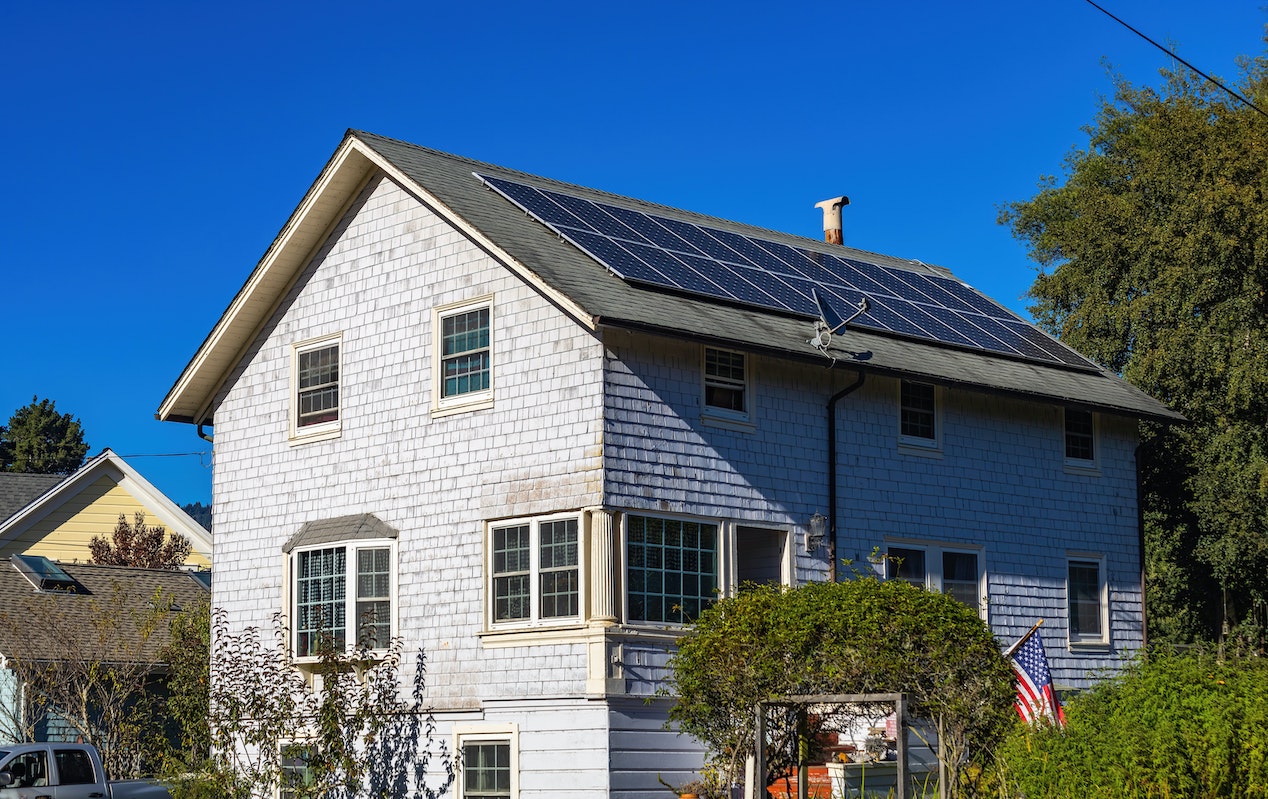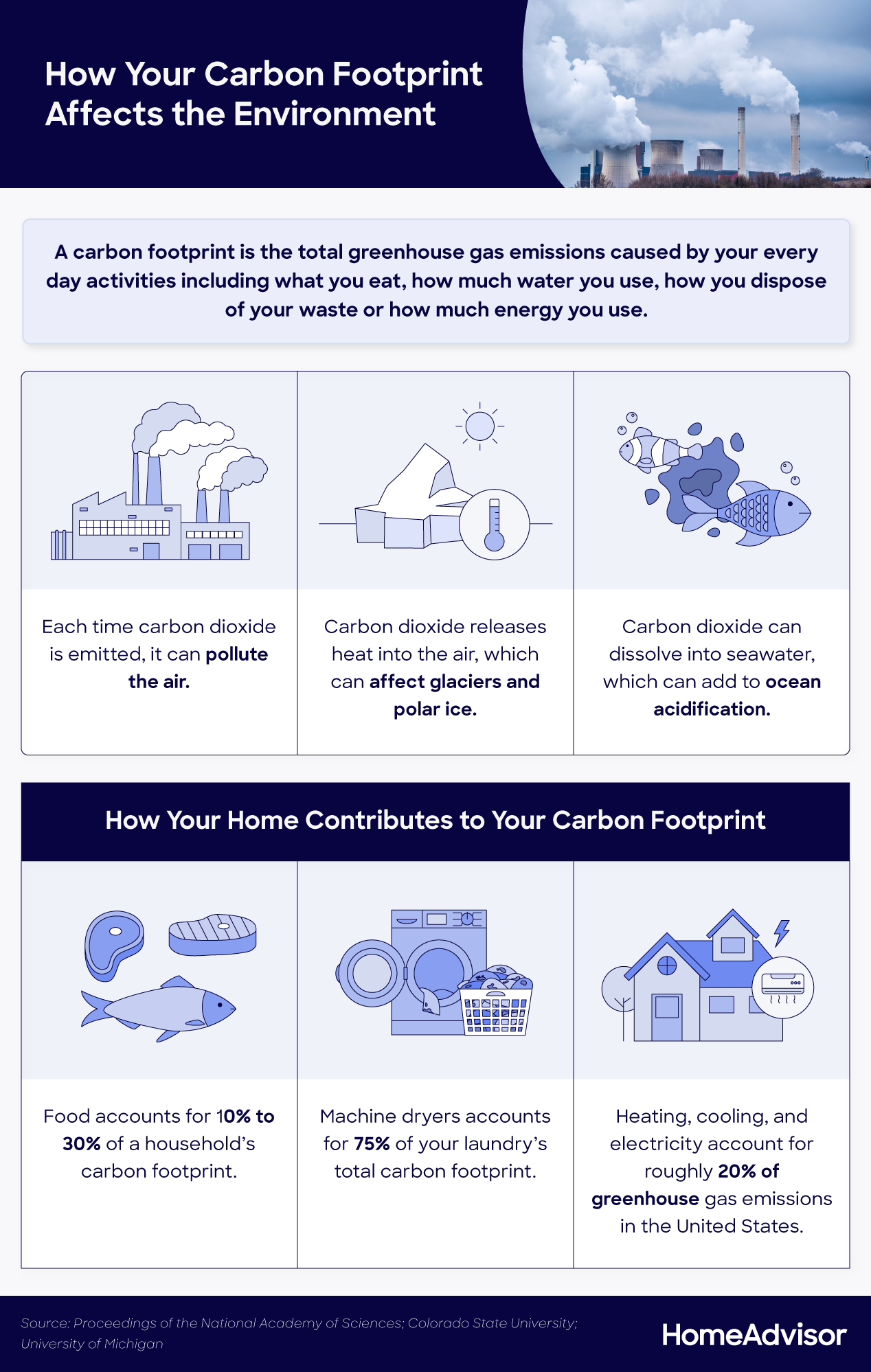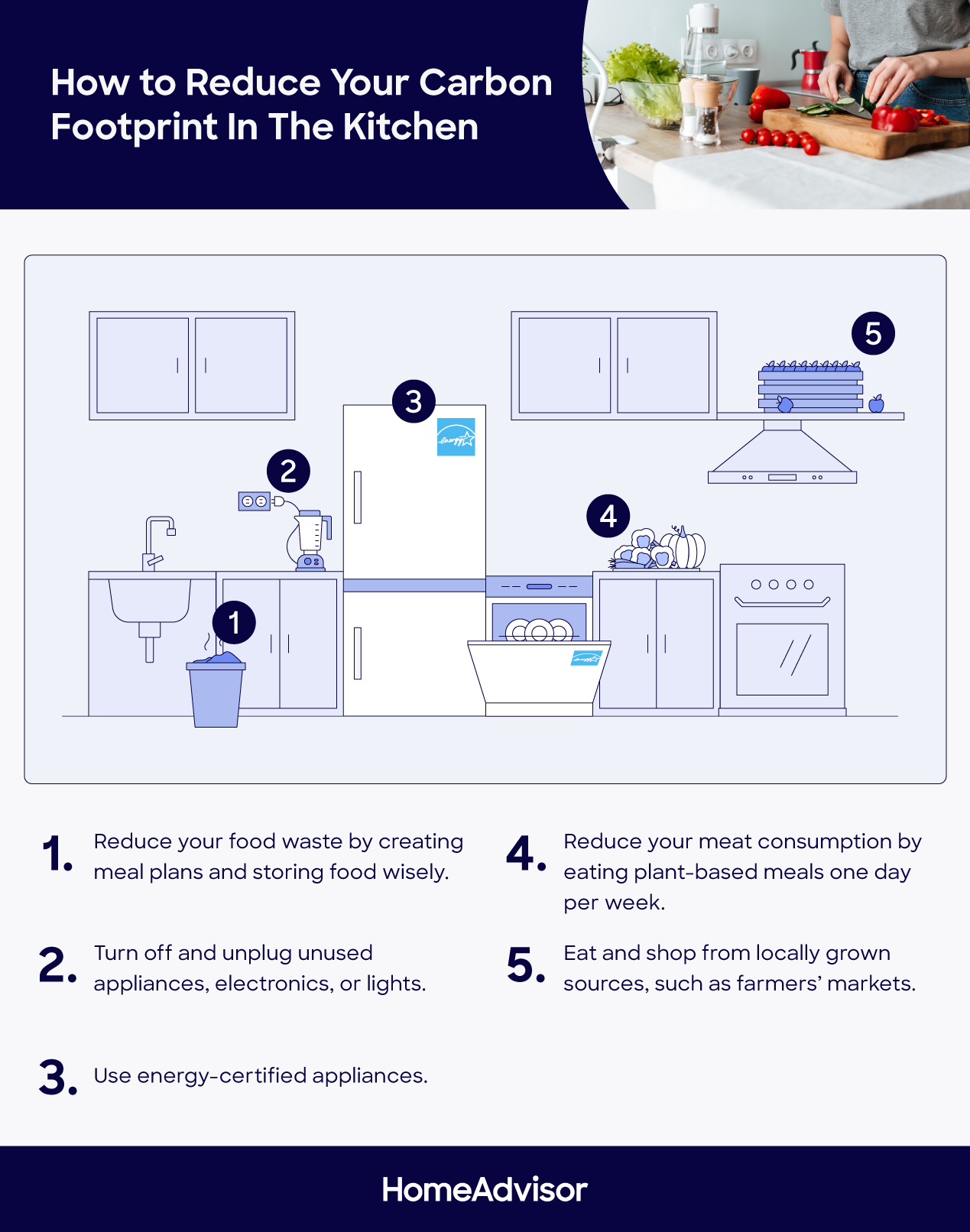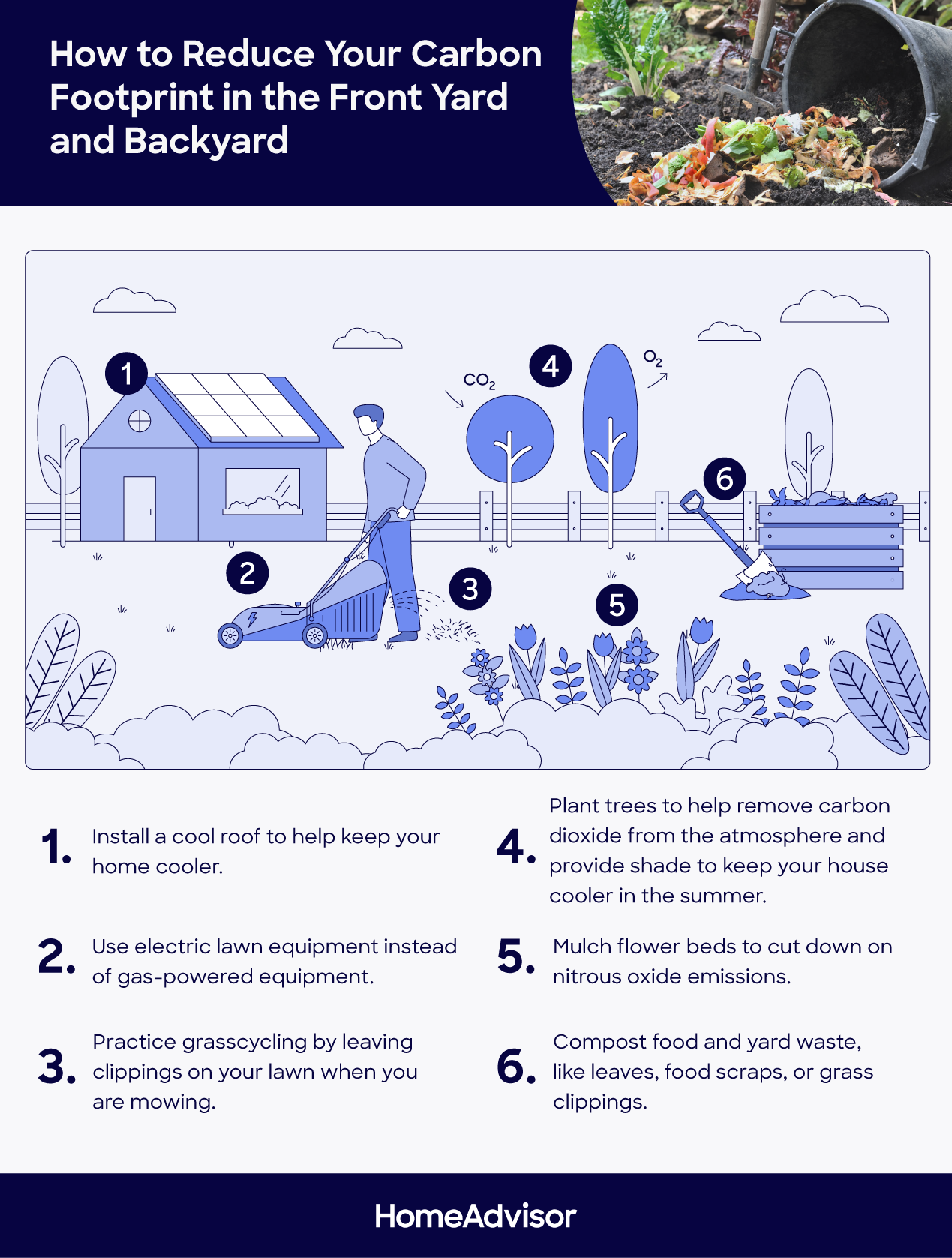
The United States has one of the highest carbon footprint rates in the world, with each person producing an average of 16 tons of greenhouse gases per year, according to data from the Environmental Protection Agency (EPA). From what we eat to how we do laundry, our actions and homes play a large role in the size of our personal carbon footprint. Fortunately, we can take steps as individuals to reduce our overall impact on the environment.
In this guide, we break down how your carbon footprint impacts the environment and ways you can reduce your greenhouse gas emissions at home.
What Is Your Carbon Footprint?
Carbon footprint refers to the total amount of greenhouse gases created by our everyday activities. How we travel, use appliances, and dispose of waste all impact our level of greenhouse gas emissions. Your household’s carbon footprint may depend on your habits, personal choices, and location.
How Your Carbon Footprint Impacts the Environment
As the name suggests, greenhouse gases (GHG) trap heat in the atmosphere and contribute to global warming. Elevated levels of carbon dioxide and other GHGs can negatively impact our environment in many ways. The following statistics show how our everyday activities factor into our carbon footprint:


Ways to Reduce Your Home’s Carbon Footprint
If you want to reduce your environmental impact, lowering your home’s carbon footprint is a great place to start. Whether you want to make your whole house eco-friendly or take it one room at a time, the following suggestions can help you lower your greenhouse emissions at home.
Entire Home
Improve the energy efficiency of your entire home by implementing the steps below.


1. Conduct a Home Energy Audit
Get the big picture by conducting a home energy audit—a comprehensive evaluation of your home’s current energy consumption and conditions. Consider reaching out to your city’s energy company or a professional home energy auditor to assist you with the assessment. The auditor can help you determine ways to implement energy-saving strategies, improve safety, and fix other potential energy issues in your home.
If you want to calculate your home’s carbon footprint, try the Environmental Protection Agency’s (EPA) carbon footprint calculator. You can get a quick estimate based on U.S. average values or generate a more accurate estimate using your utility bills.
2. Seal and Insulate Your Home
Air can leak into and out of your home through windows, walls, roofs, doors, and cracks, wasting energy and increasing utility costs. In fact, nine out of ten homes in the U.S. don’t have enough insulation. Properly insulating your home can help maintain the desired air temperature while reducing your carbon footprint.
You can also lower energy use by sealing any leaks in your home. This cost-effective step not only helps decrease the demand on your HVAC system but can also improve your indoor air quality. Both increasing insulation and decreasing leaks play an important role in saving energy in winter.
3. Switch to Energy-Efficient Lighting Products
Lighting accounts for 15% of the electricity use in an average household. Replacing incandescent light bulbs with energy-efficient LED lights helps reduce greenhouse emissions. It may also reduce your energy bill, with the average household saving about $225 a year by using LED lighting. LEDs use up to a whopping 90% less energy and last up to 25 times longer than traditional bulbs.
4. Reduce Household Waste
What we buy and throw away can impact our environment. By mindfully consuming and disposing of products, we can help save energy, conserve resources, and reduce waste. According to the EPA, plastic and paper or paperboard waste alone make up about 30% of the municipal solid waste in landfills nationally.
Recycling or reusing products—rather than tossing them—can help lower your overall carbon footprint by reducing the amount of greenhouse gases generated in production and preventing materials from entering landfills.
To decrease household waste, try the following ideas:
- Bring reusable bags to the store
- Donate clothes or repurpose old ones
- Reuse cardboard boxes, plastic bags, and paper
- Recycle cardboard, plastic film, and paper
- Use a reusable bottle for beverages
- Shop smart and buy less to reduce waste at home
Not all communities have the same recycling rules. Reach out to your local recycling center or waste disposal company to see what items you can recycle. For a list of materials you commonly can (and can’t) recycle, check out the EPA’s Frequent Questions on Recycling.
5. Lower Your Thermostat in Cooler Months and Increase It in Warmer Months
A small difference in your home’s temperature can make a big difference to the environment. By adjusting your thermostat 3 degrees Fahrenheit—down in winter and up in summer—you can reduce carbon dioxide emissions by about 1,050 pounds per year. You can also purchase and install a smart thermostat, which can assist in optimizing home temperatures while cutting costs and minimizing waste.
6. Reduce Your Water Usage
Since 3% of the nation’s energy consumption comes from pumping and treating water, conserving water conserves energy, too. Reducing your water consumption can save hundreds of gallons of water per year, reducing greenhouse gas emissions. Simple steps like turning off the water while you brush your teeth, repairing leaky toilets, running your dishwasher only when full, and watering outdoor plants during the coolest part of the day can help reduce your home’s carbon footprint.
7. Keep Your Water Heater Set to 120 Degrees
Some manufacturers set water heaters to 140 degrees Fahrenheit, but most households only require them to run at 120 degrees Fahrenheit. By lowering your water heater’s thermostat, you can reduce your carbon footprint and potentially save hundreds of dollars annually. Adjusting the water temperature to 120 degrees Fahrenheit has an additional advantage: minimizing the risk of scalding anyone using water in your home.
Kitchen
From what you eat to how you prepare your food, kitchen activities can contribute significantly to your carbon footprint. By properly setting up your kitchen, you can reduce waste and save energy—sometimes even when you’re not there.


8. Reduce Your Food Waste
When you throw food away, you also waste all the energy used to produce, transport, store, and prepare the food. The EPA estimates that food loss and waste account for 170 million metric tons of carbon dioxide each year—equivalent to 42 power plants. By making adjustments to your food habits, such as creating meal plans, eating leftovers, and storing food wisely, you can reduce the amount of food waste and lower your carbon footprint.
9. Turn Off and Unplug Unused Appliances, Electronics, or Lights
Your kitchen could be sucking up energy even when you’re not using it. Energy used by devices in standby mode accounts for 5% to 10% of residential energy consumption. Turning off any electronics, lights, or appliances not in use can help decrease the amount of energy used in your home. Depending on the number and efficiency of your devices, this step could potentially significantly lower your carbon footprint—and help you save on your utility bill, too.
10. Use Energy-Certified Appliances
When looking for new home products or appliances, look for the Energy Star label. Replacing existing appliances, such as refrigerators and dishwashers, with more energy-efficient models can help lower energy costs and potentially eliminate tons of heat-trapping gasses. For example, Energy Star room air conditioners use 9% less energy than conventional models and cost less than $70 per year to run on average.
11. Reduce Your Meat Consumption
Plant-based protein sources have a lower carbon footprint than even the lowest-impact meat products. However, even if you don’t go full vegan, limiting your meat consumption or switching to lower-impact meats can help make your diet more sustainable. Beef and lamb, for example, can emit up to 25 times more greenhouse gas emissions than eating plant-based protein sources such as tofu, beans, peas, or nuts. Whether you eat less red meat, buy farmed fish instead of pork, or stop eating animal products altogether, you’ll reduce your food carbon footprint.
12. Eat Locally Grown Food
Animal products or heavily processed and packaged foods often require significantly more energy to produce than homegrown and handmade foods sold at local farmers’ markets. Beef, dairy, pork, chicken, and eggs account for more than 75% of the U.S. diet’s carbon emissions. Sourcing your food locally and carefully choosing what you buy can reduce your carbon footprint.
Front Yard and Backyard
Besides making changes inside your home, you can take steps outdoors to reduce your household’s environmental impact.


13. Install a Cool Roof
Cool roof techniques use white coatings or other reflective materials to keep the building beneath them cooler. For example, black roofs may have a temperature 50 degrees Fahrenheit hotter than the ambient air, but white roofs are only 10 degrees Fahrenheit hotter. Cool roofs can help keep your home more comfortable and reduce your reliance on air conditioning, lowering energy bills and greenhouse gas emissions. They can also be used in combination with solar panels, which may qualify you for federal tax credits, too.
14. Use Electric Lawn Equipment
Gasoline-powered lawn and garden equipment—including leaf blowers, lawn mowers, and hedge trimmers—can emit high levels of carbon dioxide, carbon monoxide, and other air pollutants. By switching to electric motors, you’ll produce little to no emissions, which can keep the air around your home cleaner and help reduce your carbon footprint.
15. Plant Trees
Trees remove carbon dioxide from the atmosphere and release oxygen, providing cleaner and healthier air. By planting trees in your yard, you can help reduce carbon in the atmosphere and do your part to limit global warming. In addition, trees help save energy by providing shade for your home and lowering peak air temperatures. Plant trees strategically to help regulate your home’s temperature year-round: They can offer shade in summer and act as windbreaks in winter to reduce heat loss.
16. Mulch Flower Beds
Covering soil with wood mulch saves water, controls pests, insulates plants, and contributes vital nutrients to the soil. As it turns out, it may also help combat climate change. A University of British Columbia study showed that using mulch cut nitrous oxide emissions—a greenhouse gas 300 times more potent than carbon dioxide—by up to 28%.
17. Practice Grass Cycling
Yard clippings total 12.1% of all landfill waste, making it the fifth largest contributor to solid waste in landfills. However, leaving grass trimmings on your lawn can reduce the amount of waste you produce and lower your carbon footprint. Known as grasscycling, this process has added benefits that include retaining moisture, decreasing your reliance on chemical fertilizer, and lowering the time needed to care for your lawn.
18. Compost Your Food and Yard Waste
To compost your waste, you combine organic materials like leaves, grass, and food scraps and allow them to decompose. Recycling your waste has a multitude of benefits, including reducing your waste stream and lowering methane production from landfills. A Princeton University study found that composting organic waste versus putting it in a landfill can cut more than 50% of carbon dioxide-equivalent greenhouse gas emissions. Using the composted materials in your yard can also improve the soil in a way that helps you conserve water and lowers your need for fertilizer.
Bathroom
In addition to the steps you can implement in the rest of the house—such as installing LED lights and unplugging electronic devices when not in use—you can also make a few bathroom-specific changes to reduce your carbon footprint.


19. Use a WaterSense-Labeled Showerhead
Standard showerheads can use up to 2.5 gallons of water per minute, accounting for nearly 17% of residential indoor water use. Switching to a low-flow showerhead may help your household save considerable water. Showerheads with the WaterSense label not only reduce water usage, but also provide satisfactory showers equal to or better than conventional showerheads on the market.
20. Use Sustainable Personal Care Products
While you may not think about it, the personal care products you use every day can contribute to climate change. Greenhouse gases result from nearly every step of the manufacturing process: production, transportation, and disposal. You can take steps to reduce your carbon footprint in the bathroom, including checking for sustainable labels, purchasing products with minimal packaging, and recycling or repurposing containers.
Laundry Room
Like other rooms in your home, the laundry room provides multiple opportunities to reduce your carbon footprint.


21. Wash Clothes With Cold Water
About 90% of the energy used by washing machines goes toward water heating. Using cold water instead can reduce the amount of energy your machine uses, helping to decrease your energy bill and carbon footprint. In fact, switching from hot water to cold once a week can lower household GHG emissions by more than 70 pounds per year. As a bonus, your clothes may last longer, helping you buy and waste less.
22. Line Dry Your Towels and Clothes
Machine drying your clothes makes up 75% of your laundry’s carbon footprint. Dryers use energy and water, which increases your home’s carbon footprint. Simply air-drying your clothes—indoors or out in the sun—helps reduce climate impact by 67%.
23. Use Eco-Friendly Laundry Detergent Products
Like many other household products, chemical laundry detergents contribute to carbon emissions. Switching to more sustainable laundry products can help reduce your carbon footprint at home. When shopping for detergents, look for products that come in sustainable packaging and don’t have animal ingredients or Sodium Lauryl/Laureth Sulfate.

